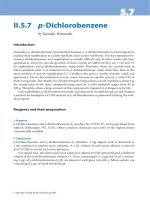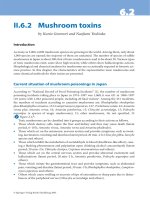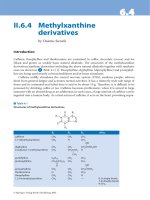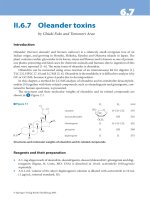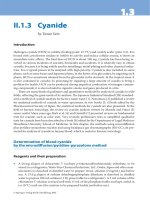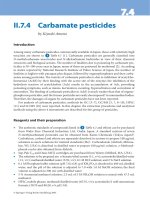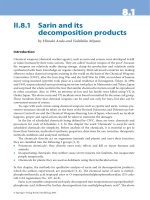Handbook of Experimental Pharmacology Volume 168 docx
Bạn đang xem bản rút gọn của tài liệu. Xem và tải ngay bản đầy đủ của tài liệu tại đây (6.56 MB, 754 trang )
Handbook of
Experimental Pharmacology
Volume 168
Editor-in-Chief
K. Starke, Freib urg i. Br.
Editorial Board
G.V.R. Born, London
M. Eichelbaum, Stuttgart
D. Ganten, Berlin
F. Hofmann, München
B. Kobilka, Stanford, CA
W. Rosenthal, Berlin
G. Rubanyi, Richmond, CA
Cannabinoids
Cont ributors
M.E.Abood,S.Bátkai,T.Bisogno,G.A.Cabral,M.J.Christie,
A.A. Coutts, S.N. Davies, R. de Miguel, L. De Petrocellis,
V. Di Marzo, M. Egertová, M.R. El phick, J. Fernández-Ruiz,
S.J. Gatley, S.T. Glaser, M. Gómez, S. Gonzáles, M. Guzmán,
C.J. Hillard, W S.V. Ho, A.G. Hohmann, A.C. Howlett,
M.A. Huestis, A.A. Izzo, M. Karsak, G. Kunos, C. Li,
A.H. Lichtman, K.P. Lindsey, M. Maccarrone, K. Mackie,
A. Makriyannis, B.R. Martin, S.P. Nikas, P. Pacher,
R.G. Pertwee, J.A. Ramos, P.H. Reggio, G. Riedel, P. Robson,
E. Schlicker, A. Staab, B. Szabo, G.A. Thak ur, O. Valverde,
C.W. Vaughan, J.M. Walker, T. Wenger, A. Zimmer
Editor
Roger G. Pertwee
123
Professor
Dr. Roger Per twee
School of Medical Sciences
Institute of Medical Science
University of Aberdeen
Foresterhill
Aberdeen AB25 2ZD
Scotland, UK
email:
With 84 Figures and 26 Tables
ISSN 0171-2004
ISBN 3-540-22565-X Springer Berlin Heidelberg New York
Library of Congr ess Control Number: 2004109756
This work is subject to copyright. All rights reserved, whether the whole or part of the material is
concerned, specifically the rights of translation, reprinting, reuse of illustrations, recitation, broad-
casting, reproduction on microfilm or in any other way, and storage in data banks. Duplication of
this publication or parts thereof is permitted only under the provisions of the German Copyright Law
of September 9, 1965, in its current version, and permission for use must always be obtained from
Springer. Violations are liable for prosecution under the German Copyright Law.
Springer is a part of Springer Science + Business Media
springeronline.com
© Springer-Verlag Berlin Heidelberg 2005
Printed in Germany
The use of general descriptive names, registered names, trademarks, etc. in this publication does not
imply, even in the absence of a specific statement, that such names are exempt from the relevant
protective laws and regulations and therefore free for general use.
Product liability: The publishers cannot guarantee the accuracy of any information about dosage and
application contained in this book. In every individual case the user must check such information by
consulting the relevant literature.
Editor : Dr. R. Lange
Desk Editor: S. Dathe
Cover design: design&production GmbH, Heidelberg, Germany
Typesetting and production: LE-T
E
XJelonek,Schmidt&VöcklerGbR,Leipzig,Germany
Printed on acid-free paper 27/3150-YL - 5 43210
I n memory of H.J.C. and Bill Paton
– and for Teresa.
Preface
Less than 20 years ago the field of cannabis and the cannab inoids was still con-
sidered a minor, somewhat q uaint, area of research. A few groups were active in
the field, but i t was already being viewed as stagnating. The chemistry of cannabis
was well known, ∆
9
-tetrahydrocannabinol (∆
9
-THC), identified in 1964, being the
only major ps ychoactive constituent and cannabidiol, which is not psychoactive,
possibly contributing to some of the effects. These cannabinoids and several syn-
thetic analogs had been thoroughly investigated for their pharmacological effects.
Their mode of action was considered to be non-specific. The reasons for this as-
sumption were both t echnical and conceptual. On the technical side, it had been
shown that THC was active in both enantiomeric forms (though with a different
level of potency) and this observation was incompatible with action on biological
substrates—a receptor, an enzyme, an ion channel—which react with a single
stereoisomer only. The conceptual problem related to THC activity. This had been
pointed out by several highly regarded research groups that had shown that many
of the effects seen with cannabinoids were related to those of biologically active
lipophiles, and that many of the effects of THC, particularly chronic ones, were
comparable to those seen with anaesthetics and solvents. The technical problems
were eliminated when it was found, by several groups, that cannabinoid action is
actually stereospecific andmostofthepreviouswork, whichhadpointedtoa differ-
entconclusion,wasbasedon ins ufficiently purified samples. Theconceptualhurdle
was over come when Allyn Howlett’s group in 1988 brought out the first evidence
that a specific cannabinoid recepto r exists in the brain. This receptor was cloned
shortly thereaft er and a second receptor, which is not present in the brain, was
identified in t he periphery. As, presuma bly, receptors do not exist in mammalian
brains for the sake of a plant constituent, several groups went ahead looking for
endogenous cannabinoids. The first such endocannabinoid, named anandamide,
was reported in 1992, and a second major one, 2-arachidonoylglycerol (2-AG), was
discovered in 1995. Several additional, apparentl y minor ones are now known.
A research flood followed. An tagonists to both receptors have been synthesized,
specific enzymes, which regulate endocannabinoidlevels, have been found, and the
biosynthetic and degradation patterns have been established. The endocannabi-
noid system has turned out to be of major biochemical importance. It is involved in
many of our physiological processes—in the nervous, digestive, reproductive, pul-
monary and immune systems. Endocannabinoids enhance appetite, reduce pain,
act as neuro pr otectan ts and regula tors of cytokine production and are someho w
involved in the extinction of memories—to mention just a few of their effects.
VIII Preface
At cannabinoid meetings in the past, very few representatives of thepharmaceu-
tical companies were present. Now the picture has changed. At least two synthetic
cannabinoids are in advanced phase III clinical trials. SR-141716, a CB
1
antagonist,
developed by Sanofi, represents a new type of appetite modulator, and HU-211,
developed by Pharmos, is a neuroprotectantin head trauma. Iftheclinical trials are
successful, both drugs may represent pharmaceutical breakthroughs in important
therapeutic areas. Numerous companies are following in their footsteps. Other
clinical condition s apparently are also being looked into. Sleep disorders, inflam-
matory condition s, neurodegenera tive diseases, liver cirrhosis and even cancer
represent possible targets.
What can we expect in the future? Compar ed to the classical neurotransmit-
ters dopamine, serot onin, norepinephrine, and acetylcholine, we still know very
little about anandamide and 2-AG. There are strong indications that additional
anandamide/cannabinoid receptors exist, but their identification and cloning is
still elusive. As both anandamide and 2-AG are arachidonic acid derivatives,
their leukotriene-type and prostaglandin-type metabolites may be of biological
importance—but, are they? It has been shown that the cannabinoids are rather
unique retrograde messengers at the synapse. But the actual messengers have no t
been identified. Are they anandamide and 2-AG? There are initial indications that
the endocannabinoid system is involved in numerous, additional, unrelated bio-
logical conditionssuch asstress, bone formation,aggression,addictive behaviours.
We know very little of any possible endocannabinoid in volvement. And the list is
long.
People smoke cannabis in order t o change their mood. The tricyclic cannabi-
noids (and possibly the endocannabinoids) certainly alter mood, social beha viour
and emotions. But we know next to nothing of the chemistry of emotions. Until
quite recently the field of emotions was left to the poets and some psychologists
and psychiatrists. From the point of view of a chemist or a pharmacologist, un-
fortunately, we have very few tools to approach problems of emotions. Could the
endocannabinoids represent such tools?
The present book is an outstanding summary of many aspects of cannabinoid
research. It represents a stepping-stone to many unsolved problems in biochem-
istry, pharmacology, physiology and the clinic. Perhaps it will help generate novel
ideas, such as how to approach the scientific study of emotions.
Sp ring, 2005
Pr ofessor Raphael Mechoulam
Department of Medicinal Chemistry
and Natural Products, Medical Faculty,
Hebrew University ,
Jerusalem 91120, Israel
(e-mail: )
List of Contributors
(Addresses stated at the beginning of the respective chapters)
Abood, M.E. 81
Bátkai, S. 599
Bisogno, T. 147
Cabral, G.A. 385
Christie, M.J. 367
Coutts, A.A. 573
Davies, S.N. 445
de Miguel, R. 643
De Petrocellis, L. 147
Di Marzo, V. 147
Egertová, M. 283
Elphick, M.R. 283
Fernández-Ruiz, J. 479
Gómez, M. 643
Gatley, S.J. 425
Glaser, S.T. 425
González, S. 479
Guzmán, M. 627
Hillard, C.J. 187
Ho, W S.V. 187
H ohmann, A.G. 509
Howlett, A.C. 53
Huestis, M.A. 657
Izzo, A.A. 573
Karsak, M. 117
Kunos, G. 599
Li, C. 209
Lichtman, A.H. 691
Lindsey, K.P. 425
Maccarrone, M. 555
Mackie, K. 299
Makriyannis, A. 209
Martin, B.R. 691
Nikas, S.P. 209
Pacher, P. 599
Pertwee, R.G. 1
Ramos, J.A. 643
Reggio, P.H. 247
Riedel, G. 445
Robson, P. 719
Schlicker, E. 327
Staab, A. 385
Szabo, B. 327
Thakur, G.A. 209
Valverde, O. 117
Vaughan, C.W. 367
Walker, J.M. 509
Wenger, T. 555
Zimmer, A. 117
List of Contents
PharmacologicalActionsofCannabinoids 1
R.G. Pertwee
Cannabinoid Recepto r Signaling . . . . . . . . . . . . . . . . . . . . . . . . 53
A.C. Howlett
Molecular Biology of Cannabinoid Receptors . . . . . . . . . . . . . . . . 81
M.E. Abood
Analysis o f the Endocannabinoid System
by Using CB
1
CannabinoidReceptorKnockoutMice 117
O. Valverde, M. Karsak, A. Zimmer
The Biosynthesis, Fate and Pharmacological Properties
of Endocannabinoids . . . . . . 147
V. Di Marzo, L. De Petrocellis, T. Bisog no
Modulators of Endocannabinoid Enzymic Hydrolysis
andMembraneTransport 187
W S.V. Ho, C.J. Hillard
Structural Requirements for Cannabinoid Receptor Probes . . . . . . . . . 209
G.A. Thakur, S.P. Nikas, C. Li, A. Makriyannis
Cannabinoid Recepto rs and Their Ligands: Ligand–Ligand
and Ligand–Receptor Modeling Approaches . . . . . . . . . . . . . . . . . 247
P. H . Re g g i o
The Phylogenetic Distribution and Evolutionar y Origins
of Endocannab inoid Signalling . . . . . . . . . . . . . . . . . . . . . . . . 283
M.R. Elphick, M. Egertová
Distribution of Cannabinoid Receptors in the Central
andPeripheralNervousSystem 299
K. Ma ckie
EffectsofCannabinoidsonNeurotransmission 327
B. Szabo, E. Schlicker
XII List of Contents
Retrograde Signalling by Endocannabinoids . . . . . . . . . . . . . . . . . 367
C.W. Vaughan, M.J. Christie
EffectsontheImmuneSystem 385
G.A. Cabral, A. Staab
ImagingoftheBrainCannabinoidSystem 425
K.P. Lindsey, S.T. Glaser, S.J. Gatley
Cannabinoid F unction in Learning, Memory and Plasticity . . . . . . . . . 445
G. Riedel, S.N. Davies
Cannabinoid Control of Motor Function at the Basal Ganglia . . . . . . . . 479
J. Fernández-Ruiz, S. González
Cannabinoid Mechanisms o f Pain Suppression . . . . . . . . . . . . . . . . 509
J.M. Walker, A.G. Hohmann
Effects of Cannabinoids on Hypothalamic
andReproductiveFunction 555
M. Maccarrone, T. Wenger
CannabinoidsandtheDigestiveTract 573
A.A. Izzo, A.A. Coutts
CardiovascularPharmacologyofCannabinoids 599
P. P a cher, S. Bá tkai, G. Kunos
EffectsonCellViability 627
M. Guzmán
EffectsonDevelopment 643
J.A. Ramos, M. Gómez, R. de Miguel
Pharmacokinetics and Metabolism of the Plant Cannabinoids,
∆
9
-Tetrahydrocannabinol, Cannabidiol and Cannabinol . . . . . . . . . . . 657
M.A. Huestis
CannabinoidToleranceandDependence 691
A.H. Lichtman, B.R. Martin
Human Studies of Cannabinoids and Medicinal Cannabis . . . . . . . . . . 719
P. R o b so n
Subject I ndex 757
HEP (2005) 168:1–51
c
Springer-Verlag 2005
Pharmacological Actions of Cannabinoids
R.G. Pertwee
School of Medical Sciences, Institute of Medical Sciences, University of Aberdeen,
Foresterhill, Aberdeen AB25 2ZD, UK
1Introduction 2
2 Bioassays for Characterizing CB
1
and CB
2
Receptor Ligands 6
2.1 InVitroBindingAssays 6
2.2 In Vitro Functional Bioassays 9
2.2.1AssaysUsingWholeCellsorCellMembranes 9
2.2.2IsolatedNerve–SmoothMusclePreparations 11
2.3 In Vivo Bioassays 11
2.4 CannabinoidReceptorKnockoutMice 12
3CB
1
and CB
2
Cannabinoid Receptor Ligands 13
3.1 CannabinoidReceptorAgonists 13
3.2 Cannabinoid CB
1
and CB
2
ReceptorAntagonists 20
3.2.1 Selective CB
1
ReceptorAntagonists 20
3.2.2 Selective CB
2
ReceptorAntagonists 22
3.3 InverseAgonismatCannabinoidReceptors 22
3.4 NeutralAntagonismatCannabinoidReceptors 24
4 Other Pharmacological Targets for Cannabinoids in Mammalian Tissues 26
4.1 Receptors 26
4.1.1VanilloidReceptors 26
4.1.2 CB
1
ReceptorSubtypes 27
4.1.3 CB
2
-LikeReceptors 27
4.1.4 Neuronal Non-CB
1
,Non-CB
2
,Non-TRPV1Receptors 28
4.1.5ReceptorsforAbnormal-Cannabidiol 33
4.2 AllostericSites 35
4.3 Some CB
1
-andCB
2
-Independent Actions of Cannabidiol, HU-211
andOtherPhenol-ContainingCannabinoids 36
4.3.1NeuroprotectiveActions 36
4.3.2OtherActionsofCannabidiol 37
5CB
1
Receptor Oligomerization 38
6FutureDirections 38
References 39
Abstract Mammalian tissues expr e ss at least two types of canna binoid receptor,
CB
1
andCB
2
, both Gproteincoupled.CB
1
receptors are expressedpredominantly at
nerve terminalswheretheymediate inhibition of transmitterrelease. CB
2
receptors
2 R.G. Pertwee
are found mainly on immune cells, one of their roles being to modulate cytokine
release. Endogenous ligands for these receptors (endocannabinoids) also exist.
These are al l eicosanoids; prominent examples include arachidonoylethanolamide
(anandamide) and 2-arachidonoyl glycerol. These discov eries have led to the de-
velopment of CB
1
-andCB
2
-selective agonists and antagonists and of bioassays
for characterizing such ligands. Cannabinoid receptor antago nists include the
CB
1
-selective SR141716A, AM251, AM281 and LY320135, and the CB
2
-selective
SR144528 and AM630. These all behave as inver se agonists, one indication that
CB
1
and CB
2
receptors can exist in a constitutively active state. Neutral cannabi-
noid receptor antagoniststhat seem to lack inverse agonist properties ha ve recently
also been developed. As well as acting on CB
1
and CB
2
rece ptors, there is convinc-
ing evidence that anandamide can activate transient receptor potential vanilloid
type 1 (TRPV1) receptors. Certain cannabinoids also appear to have non-CB
1
,
non-CB
2
, non-TRPV1 targets, for example CB
2
-like receptors that can mediate
antinociception and “abno rmal-cannabidiol” recepto rs that mediate vasorelax-
ation and promote microglial cell migration. There is evidence too for TRPV1-like
receptors on glutamatergic neuron s, for α
2
-adrenoceptor-like (imidazoline) re-
ceptors at sympathetic nerve terminals, for novel G protein-coupled receptors for
R-(+)-WIN55212 and anandamide in the brain and spinal cord, for novel recep-
tors for ∆
9
-tetrahydrocannabinol and cannabinol on perivascular sensory nerves
and for novel anandamide receptors in the gastro-intestinal tract. The presenc e
of allosteric sites for cannabinoids on various ion channels and non-cannabinoid
receptors has also been pro posed. In additio n, more information is beginning to
emerge about the pharmacological actions of the non-psychoactive plant cannabi-
noid, cannabidiol. These recent advances in cannabino id pharmacology are all
discussed in this review.
Keywords Cannabinoid receptors · Cannabinoid receptor agonists and antago-
nists · Abnormal-cannabidiol · Cannabidiol · Inverse agonism
1
Introduction
“Cannabinoid” was originally the collective name given to a setof oxygen-contain-
ing C
21
aromatic hydrocarbon compounds that occur naturally in the plant Canna-
bis sativa (ElSohly 2002; Mechoulam and Gaoni 1967). However, this term is no w
generally also used for all naturally occurring or synthetic compounds that can
mimictheactionsofplant-derivedcannabinoidsorthathavestructuresthatclosely
resemble those of plant cannabinoids. Consequently, a separate term, “phyto-
cannabinoid”, has been coined for the cannabinoids produced by cannabis (Pate
1999). One phytocannabinoid, ∆
9
-tetrahydrocannabinol (∆
9
-THC; Fig. 1), has at-
tracted particular attention. This is because it isthe main psychoactive constituent
of cannabis (reviewed in Pertwee 1988) and because it is one of just two cannabi-
noids t o be licensed for medical use, the other being nabilone (Cesamet; Fig. 2),
a synthetic analogue of ∆
9
-THC (reviewed in the chapter b y Robson, this vol-
Pharmacological Actions of Cannabinoids 3
Fig. 1. The structures of four plant cannabinoids, ∆
9
-THC, ∆
8
-THC, cannabinol and cannabidiol
Fig. 2. The structure of nabilone
ume). Because of its high lipid solubility and low water solubility, ∆
9
-THC was
long thought to owe its pharmacological properties to an ability to perturb the
phospholipid constituents of biological membranes (reviewed in Pertwee 1988).
However, all thischanged in the late 1980swith the discovery inmammaliantissues
of specific cannabinoid receptors.
Two types of cannabinoid receptor have so far been identified (reviewed in
Howlett et al. 2002). These are CB
1
, cloned in Tom Bonner’s labora tory in the U SA
in 1990, and CB
2
, cloned by Sean Munro in the UK in 1993. Both these receptors
are coupled through G
i/o
proteins, negatively to adenylate cyclase and positively
to mitogen-activated protein kinase. CB
1
receptors are also coupled through G
i/o
proteins, positively to A-type and inwardly rectifying potassium channels and
negatively to N-type and P/Q-type calcium channels and to D-type potassium
channels. In addition, there are reports that CB
1
and CB
2
receptors can enhance
intracellular free Ca
2+
concentrations (Fan and Yazulla 2003; Ru bovitch et al. 2002;
Sugiura et al. 1996, 1997, 2000). It is unclear whether this enhancement is G
i/o
4 R.G. Pertwee
mediated. In experiments with NG108-15 cells, Sugiura et al. (1996) found CB
1
-
mediated increases in intracellular free Ca
2+
levels to be abolished by pretreatment
with pertussis to xin, pointing to an involvement of G
i/o
proteins. However, in
experiments with N18TG2 neuroblastoma cells, Rubovich et al. (2002) reported
that pertussis toxin failed to prevent CB
1
-mediated enhancement of intracellular
free Ca
2+
levels by lo w concentrations of desacetyl-l-nantradol, a cannabinoid
rece ptor agonist (Sect. 3.1), and instead unmasked a stimulatory effect of higher
concentrations of this agonist that in the absence of pertussis toxin did not alter
intracellular fr ee Ca
2+
levels at all. Rubovich et al. (2002) also obtained evidence
that the stimulatory effect of desacetyl-l-nantradol on intracellular Ca
2+
release
depended on an ability to delay the inactivation of open L-type voltage-dependent
calciumchannelsand that itwasmediatedmainlybycyclicAMP-dependentprotein
kinase (PKA).
Although there is no doubt that G
i/o
proteins play a major role in cannabinoid
receptor signalling, there is also no doubt that trans fected and naturally expressed
CB
1
receptorscan act through G
s
pr oteins toactivate adenylate cyclase(Calandra et
al. 1999;Glass and Felder 1997; Maneuf andBrotchie 1997).The extent to whichCB
1
receptors signal through G
s
proteins may be determined by CB
1
receptor location
or by cross-talk with colocalized G protein-coupled non-CB
1
receptors (Breivogel
and Childers 2000; Calandra et al. 1999; Glass and Felder 1997; Jarrahian et al.
2004). As proposed by Calandra et al. (1999), it is also possible that there are
distinct s ubpopulations CB
1
receptors, one coupled to G
i/o
proteins and the other
to G
s
. Additional signalling mechanisms for cannabinoid CB
1
and CB
2
receptors
have been proposed and descriptions of these can be found elsewhere (Howlett et
al. 2002; see also the chapter by Howlett, this volume).
CB
1
receptors are expressed by central and peripheral neurons and also by some
nonneuronal cells (reviewed inHowlett et al. 2002; Pertwee 1997; see also the chap-
ter by Mackie, this volume). Within the central nervous system, the distribution
pattern of CB
1
receptors is heterogeneous and can account for several of the char-
acteri stic pharmacological properties of CB
1
receptor agonists. For example, the
presence of large po pulations of CB
1
receptors in cerebral cortex, hippocampus,
caudate-putamen, substantia nigra pars reticulata, globus pallidus, entopeduncu-
lar nucleus and cerebellum, as well as in some areas of the brain and sp inal cord
thatprocess or modulate nociceptive informa tion,probably accounts forthe ability
of CB
1
receptor agonists to impair cognition and memory, to alter the control of
motor function and to produce antinociception (reviewed inIversen 2003; Pertwee
2001; see also the chapters by Riedel and Davies, Fernández-Ruiz and González,
and Walker and Hohmann, this volume). Some CB
1
receptors are located at ce ntral
and peripheral nerve terminals. Her e they modulate the release of excitatory and
inhibitory neurotransmitters when activated (Howlett et al. 2002). Although the
effect of CB
1
receptor agonists on release that has been most often observed is
one of inhibition, there has been one report that the CB
1
/CB
2
receptor agonist,
R-(+)-WIN55212 (Sect. 3.1), can act through CB
1
receptors to stimulate release of
glutamate from primary cultures of rat cerebral cortical neurons (Ferraro et al.
2001). This effect, which disappeared when the concentration of R-(+)-WIN55212
wasincreasedfrom1or10nMto100nM,wasmostprobablytriggeredbycal-
Pharmacological Actions of Cannabinoids 5
Fig. 3. The structures of five putative endogenous cannabinoids
cium released from inositol 1,4,5-triphosphate-controlled intracellular stores in
responsetoaCB
1
receptor-mediated activation of phospholipase C. CB
2
receptors
are expressed mainly by immune cells that include lymphocytes, macrophages,
mast cells, natural killer cells, peripheral mononuclear cells and microglia (re-
viewed in Howlett et al. 2002; Pertwee 1997; see also the chapter by Cabral and
Staab,thisvolume).LessisknownabouttherolesofCB
2
than of CB
1
receptors,
although there is good evidence that CB
2
receptors can trigger microglial cell mi-
gration (Sect. 4.1.5) and regulate cytokine release. Thus, one property CB
1
and CB
2
receptors share is the ability to modulate ongoing release of chemical messengers.
The discovery of cannabinoid receptors was followed by the demonstration that
mammalian tissues can produce endogenous agonists for these receptors, all of
which haveso farproved tobederivativesofarachidonicacid (reviewed inDi Marzo
et al. 1998; Hillard 2000; Mechoulam et al. 1998; see also the chapter by Di Marzo
et al., this volume). The most investigated o f these “endocannabinoids” have been
arachidonoylethanolamide (anandamide) and 2-arachidonoyl glycerol (Fig. 3),
bothofwhicharesynthesizedondemandratherthanstored.Othercompoundsthat
may b e endocannabinoids include 2-arachidonylglyceryl ether (noladin ether), O-
arachidonoylethanolamine (virodhamine) and N-arachidonoyl dopamine (How-
lett et al. 2002; Porter et al. 2002; Walker et al. 2002). Endocanna binoids together
with cannabinoid receptors constitute what is now usually referred to as the “en-
docannabinoid system”. It is likely that endocannabinoids function as both neu-
romodulators and immunomodula tors and indeed, there is already evidence that
within the central nervous system they serve as retr ograde synaptic messengers
6 R.G. Pertwee
(reviewed in the chapter by Vaughan and Christie, this volume). There is also evi-
dence that f ollowing their release, anandamide and 2-arachidonoyl glyc erol enter
cells by a combination of simple diffusion and facilitated, carrier-mediated trans-
port (reviewed in Hillard and Jarrahian 2003) and are then metabolized by intra-
cellular enzymes, anandamide by fatty acid amide hydrolase and 2-arachidonoyl
glycer ol mainly by monoacylglycerol lipase (monoglyceride lipase) but also by
fatty acid amide hydrolase (reviewed in Cravatt and Lichtman 2002; Dinh et
al. 2002; Ueda 2002; van der Stelt and Di Marzo 2004; see also the chapter by
Di Marzo et al., this volume). Noladin ether also seems to be a substrate for
anandamide/2-arachidonoyl glycerol membrane transporter(s) (Fezza et al. 2002).
The processes responsible for the production, membrane tran sport and enzymic
inactivatio n of endocannabinoids are all pharmacological targets through which
the activity of the endocannabinoid system can or might be modulated to ex-
perimental or therapeutic advantage (r eviewed in the chapters by Howlett and
by Di Marzo et al., this volume). There is evidence that such modulation may
also take place naturally as a resul t of the co-release of endogenous fatty acid
deriva tives such as palmito ylethanolamide and oleamide, which can potentiate
anandamide, or of 2-linoleyl glycerol and 2-palmitoyl glycerol, which can poten-
tiate 2-arachidonoyl glycerol (Mechoulam et al. 1998). For anandamide, mecha-
nisms through which co-released ligands induce this “entourage effect” include
not only inhibition of its metabolism by fatty acid amide hydrolase but also in-
creases in the sensitivity of CB
1
or vanilloid r eceptors or of other pharmacological
targets for anandamide through allosteric o r other mechanisms (De Petrocel-
lis et al. 2001b, 2002; Franklin et al. 2003; Mechoulam et al. 1998; Smart et al.
2002).
This chapter describes the in vitro and in vivo bioassays that have been most
widely used to characterize ligands for CB
1
and/or CB
2
receptors and reviews the
ability of compounds commonly used in cannabinoid research as experimental
tools to activate or block these receptors. The likelihood that the most widely
used cannabinoid receptor antagonists are inverse agonists rather than neutral
antagonists is also discussed, as is evidence for the presence in mammalian tissues
of non-CB
1
, non-CB
2
pharmacological targets for cannabinoids.
2
Bioassays for Characterizing CB
1
and CB
2
Receptor Ligands
2.1
In Vitro Binding Assays
Several cannabinoid receptor ligands have been radiolabelled with tritium, and
thesehavebeenusedbothtodeterminetheCB
1
and CB
2
receptor affinities of unla-
belled cannabinoids in displacement assays and to establish the tissue distribution
patterns of these receptors (reviewed in Howlett et al. 2002; Pertwee 1999a). As
indicated in Tables 1, 2 and 3, some of these compounds bind more readily to CB
1
or to CB
2
receptors, whilst the others bind more or less equally well to both these
Pharmacological Actions of Cannabinoids 7
Table 1. Typical dissociation constant (K
D
) values of radiolabelled ligands at cannabinoid receptor CB
1
and
CB
2
binding sites
Radioligand Source of membranes Receptor K
D
(nM) Reference(s)
[
3
H]SR141716A Rat brain
a
rCB
1
0.19–1.20 For references,
Guinea-pig forebrain g-pCB
1
1.24 see Pertwee 1999a
[
123
I]AM251 Rat cerebellum rCB
1
0.25
[
3
H]R-(+)-WIN55212 Rat cer ebellum rCB
1
1.89, 4.67, 8.6
Guinea-pig forebrain g-pCB
1
2.34
Cultured cells
b
rCB
1
2.60
Cultured cells
b
hCB
1
16.2, 11.9
Cultured cells
b
hCB
2
3.7, 3.8
[
3
H]HU-210 Rat brain minus brain stem rCB
1
0.045
(HU-243) Cultured cells
b
hCB
2
0.061
[
3
H]CP55940 Cultured cells
b
hCB
1
0.4 to 3.3 For references,
Cultured cells
b
rCB
1
4seePertwee
Rat brain
a
rCB
1
0.07 to 2.3 1997, 1999a
Mouse whole brain mCB
1
3.4
Cultured cells
b
hCB
2
0.2 to 7.4
Cultured cells
b
mCB
2
0.39
[
3
H]CP55940 Rat cerebellum rCB
1
2.37 Mauler et al. 2002
Human cerebral cortex hCB
1
1.29
Cultured cells
b
hCB
1
1.10
Cultured cells
b
hCB
2
4.20
[
3
H]BAY 38-7271 Rat cerebellum rCB
1
1.84 Mauler et al. 2002
Human cerebral cortex hCB
1
2.10
Cultured cells
b
hCB
1
2.91
Cultured cells
b
hCB
2
4.24
g-pCB
1
,Guinea-pigCB
1
receptors; hCB
1
and hCB
2
, human cannabinoid receptors; mCB
1
and mCB
2
, mouse
cannabinoid receptors; rCB
1
and rCB
2
, rat cannabinoid receptors.
a
Whole brain or a discrete area.
b
Cells transfected with CB
1
or CB
2
receptors.
receptor types. It is noteworthy, therefore, that CB
1
or CB
2
selectivity can still be
achieved in displacement assays with the non-selective radiolabelled ligands by
using membranesobtained fromcannabinoidreceptor -freecultured cells that have
been transfected with CB
1
or CB
2
receptors or membranes obtained from brain
(CB
1
-rich) or spleen (CB
2
-rich). Some care is needed in interpreting binding data
obtained with brain or spleen membranes. Thus, whilst there is little evidence that
CB
2
receptors are expressed by central neurons, these receptors are expressed by
microglial cells (Howlett et al. 2002). Similarly, although it is mainly CB
2
receptors
that are p resent in spleen, this tissue also expresses some CB
1
receptors (reviewed
in Howlett et al. 2002; Pertwee 1997). Moreover, there is growing evidence for
the presence in brain and other tissues of non-CB
1
, non-CB
2
cannabinoid recep-
8 R.G. Pertwee
Table 2. Examples of K
i
values of certain cannabinoid CB
1
and/or CB
2
receptor agonists for the in vitro
displacement of [
3
H]CP55940, [
3
H]HU243 or [
3
H]BAY-38-7271 from CB
1
-andCB
2
-specific binding sites
(continuedonnextpage)
Agonist CB
1
CB
2
Reference
K
i
value (nM) K
i
value (nM)
CB
1
-selective agonists in order of decreasing CB
1
/CB
2
selectivity
ACEA 1.4
a,b
>2,000
a,b
Hillard et al. 1999
5.29
a,b
195
c
Lin et al. 1998
O-1812 3.4
b
3,870
b
Di Marzo et al. 2001
ACPA 2.2
a,b
715
a,b
Hillard et al. 1999
2-Arachidonyl glyceryl ether 21.2
b
>3,000
d
Hanus et al. 2001
R-(+)-methanandamide 17.9
a,b
868
c
Lin et al. 1998
20
a,b
815
c
Khanolkar et al. 1996
28.3
b
868
c
Goutopoulos et al. 2001
Agonists without any marked CB
1
or CB
2
selectivity
Anandamide 61
a,b
1,930
c
Lin et al. 1998
78.2
a,b
1,926
c
Khanolkar et al. 1996
89
a
371
a
Showalter et al. 1996
543 1,940 Felder et al. 1995
71.7
a,b
279
a,b
Hillard et al. 1999
252
e,d
581
e,d
Mechoulam et al. 1995
BAY 38-7271 1.85
f
5.96
f
Mauler et al. 2002
2-Arachidonoyl glycerol 472
e,d
1,400
e,d
Mechoulam et al. 1995
58.3
e,d
145
e,d
Ben-Shabat et al. 1998
O-1057 4.4 11.2 Pertwee et al. 2000
HU-210 0.0608 0.524 Felder et al. 1995
0.1
e,b
0.17
e
Rhee et al. 1997
0.73 0.22 Showalter et al. 1996
CP55940 5 1.8 Ross et al. 1999a
3.72 2.55 Felder et al. 1995
1.37
b
1.37
b
Rinaldi-Carmona et al. 1994
0.58 0.69 Showalter et al. 1996
0.50
a,b
2.80
a,b
Hillard et al. 1999
∆
9
-THC 53.3 75.3 Felder et al. 1995
39.5
e,b
40
e
Bayewitch et al. 1996
40.7 36.4 Showalter et al. 1996
80.3
e,b
32.2
e
Rhee et al. 1997
35.3
b
3.9
b
Rinaldi-Carmona et al. 1994
5.05 3.13 Iwamura et al. 2001
Nabilone 1.84 2.19 Gareau et al. 1996
∆
8
-THC 47.6
b
39.3
c
Busch-Petersen et al. 1996
44
b
44 Huffman et al. 1999
Cannabinol 211.2
e,b
126.4
e
Rhee et al. 1997
308 96.3 Showalter et al. 1996
1,130 301 Felder et al. 1995
CP56667 61.7 23.6 Showalter et al. 1996
R-(+)-WIN55212 9.94
b
16.2
b
Rinaldi-Carmona et al. 1994
4.4
a,b
1.2
a,b
Hillard et al. 1999
Pharmacological Actions of Cannabinoids 9
Table 2. (continued)
Agonist CB
1
CB
2
Reference
K
i
value (nM) K
i
value (nM)
1.89 0.28 Showalter et al. 1996
62.3 3.3 Felder et al. 1995
123 4.1 Shire et al. 1996
9.87 0.29 Iwamura et al. 2001
CB
2
-selective agonists in order of increasing CB
2
/CB
1
selectivity
AM1241 280
b
3.4
c
Ibrahim et al. 2003
3-(1
1
-dimethylbutyl)-1- 677
b
3.4 Huffman et al. 1999
deoxy-
∆
8
-THC (JWH-133)
L-759633 1,043 6.4 Ross et al. 1999a
15,850 20 Gareau et al. 1996
L-759656 529
b
35 Huffman et al. 1999
713
b
57 Huffman et al. 2002
4,888 11.8 Ross et al. 1999a
>20,000 19.4 Gareau et al. 1996
HU-308 >10,000
e,b
22.7
e,d
Hanus et al. 1999
See Figs. 1 to 9 for the structures of the compounds listed in this table.
DMH, dimethylheptyl; ND, not determined; THC, tetrahydrocannabinol.
a
With phenylmethylsulphonyl fluoride (PMSF) in order to inhibit enzymic hydrolysis.
b
Binding to rat cannabinoid receptors on transfected cells or on brain (CB
1
) or spleen tissue (CB
2
).
c
Binding to mouse brain (CB
1
) or spleen tissue (CB
2
).
d
Species unspecified. All other data from experiments with human cannabinoid receptors.
e
Displacement of [
3
H]HU243 from CB
1
-andCB
2
-specific binding sites.
f
Displacement of [
3
H]BAY-38-7271 from CB
1
-andCB
2
-specific binding sites.
tors to which at least some CB
1
and/or CB
2
rece ptor ligands can bind (Sect. 4).
Radiolabelled probes for single photon emission computed tomography (SP ECT)
or positron emission tomography (PET) have also been developed (reviewed in
Gifford et al. 2002; see also the chapter by Lindsey et al., this volume).
2.2
In Vitro Functional Bioassays
2.2.1
Assays Using Whole Cells or Cell Membranes
The most commonly em ployed assays using whole cells or cell membranes are
the [
35
S]guanosine-5
-O-(3-thiotriphosphate) ([
35
S]GTPγS) binding assay and the
cyclic AMP assay. The first measures cannabinoid receptor agonist-stimulated
binding to G proteins of the hydrolysis-resistant GTP analogue, [
35
S]GTPγS,
whereas the cyclic AMP assay relies on cannabinoid receptor -mediated inhibition
(usual effect) or enhancement of basal or drug-induced cyclic AMP production
10 R.G. Pertwee
Table 3. K
i
values of cannabinoid receptor antagonists/inverse agonists for the in vitro displacement of
[
3
H]CP55940 from CB
1
-andCB
2
-specific binding sites
Ligand CB
1
CB
2
Reference
K
i
value (nM) K
i
value (nM)
CB
1
-selective antagonists/inverse agonists
NESS 0327 0.00035
a
21
a
Ruiu et al. 2003
SR141716A 11.8 13,200 Felder et al. 1998
11.8 973 Felder et al. 1995
12.3 702 Showalter et al. 1996
5.6 >1,000 Rinaldi-Carmona et al. 1994
1.98
b
>1,000
b
Rinaldi-Carmona et al. 1994
1.8
a
514
a
Ruiu et al. 2003
AM281 12
b
4,200
a
Lan et al. 1999a
AM251 (compound 12) 7.49
b
2,290
a
Lan et al. 1999b
LY 320135 141 14,900 Felder et al. 1998
CB
2
-selective antagonists/inverse agonists
AM 630 5,152 31.2 Ross et al. 1999a
SR144528 437 0.60 Rinaldi-Carmona et al. 1998
305
b
0.30
b
Rinaldi-Carmona et al. 1998
>10,000 5.6 Ross et al. 1999a
70
a
0.28
a
Ruiu et al. 2003
50.3 1.99 Iwamura et al. 2001
See Figs. 10 and 11 for the structures of the compounds listed in this table.
a
Binding to mouse brain (CB
1
) or spleen tissue (CB
2
).
b
Binding to rat cannabinoid receptors on transfected cells or on brain (CB
1
) or spleen tissue (CB
2
).
All other data from experiments with human cannabinoid receptor.
(reviewed in Howlett et al. 2002; Pertwee 1997, 1999a). Both assays can be per-
formed with membranes obtained from brain tissue or from cultured cells that
express CB
1
or C B
2
receptors either naturally or after transfection. In addition, the
cyclic AMP assay can be performed with whole cells, including primary cultures of
central neuro ns, and the [
35
S]GTPγS assay can be used in autoradiography exper-
iments with tissue sections (Breivogel et al. 1997; Selley et al. 1996; Sim et al. 1995).
The cyclic AMP assay is more sensitive than the [
35
S]GTPγS assay. Presumably
this is because modulation of cyclic AMP production takes place further along the
signalling cascade than [
35
S]GTPγS binding so that there is greater signal amplifi-
cation. For the [
35
S]GTPγS assay, it is important to include guanosine diphosphate
(GDP) and sodium chloride at appropriate concentration s (Breiv ogel et al. 1998;
Selley et al. 1996; Sim et al. 1995). GDP increases the ratio of agonist-stimulated
to basal [
35
S]GTPγS binding (signal-to-noise ratio) but also decreases the abso-
lute levels of both agonist-stimulated and basal [
35
S]GTPγS binding. In addition,
it magnifies the differences in efficacy exhibited in this assay by full and partial
agonists (Savinainen et al. 2001). The signal-to-noise ratio in this bioassay can be
further improved by including an adenosine A
1
receptor antagonist (Savinainen
Pharmacological Actions of Cannabinoids 11
et al. 2003). It has also proved possible to assay cannabinoid receptor agonists
by exploiting their ability to increase intracellular free Ca
2+
levels (CB
1
and CB
2
agonists) (Bisogno et al. 2000; Rubovitch et al. 2002; Sugiura et al. 1996, 1997, 2000;
Suhara et al. 2001) or to inhibit lipopolysaccharide-induced release of tumour
necrosis factor-
α (CB
2
agonists) (Wrobleski et al. 2003). Some information about
the pharmacological properties of cannabinoid receptor ligands has also been o b-
tained using bioassays performed with cultured neurons that exploit the negative
coupling of the CB
1
receptor to N- and P/Q-type calcium channels (reviewed in
Pertwee 1997, 1999a).
2.2.2
Isolated Nerve–Smooth Muscle Preparations
Preparations in which cannabinoid receptor agonists can act through neuronal
CB
1
receptors to produce a concentration-related inhibition both of electrically-
evoked c ontractile transmitter release (Schlicker et al. 2003; Trendelenburg et
al. 2000) and of the contractions caused by this release (reviewed in Howlett
et al. 2002; Pertwee 1997; Pertwee et al. 1996a; Schlicker and Kathmann 2001)
are called isolated nerve–smooth muscle pre parations. The ones most commonly
used are the mouse vas deferens and the myenteric plexus-longitudinal mus-
cle preparation of guinea-pig small intestine. However, CB
1
receptor agonists
also sho w activity in other isolated nerve-smooth muscle preparations, for ex-
ample the rat vas deferens and the mouse urinary bladder. The usual mea-
sured response in these bioassays is inhibition of electrically evoked contrac-
tions, a response that can also be elicited in these tissues by agonists for several
types of non-cannabinoid receptor. Consequently, to establish whether or not the
production of such inhibition by a test compound is CB
1
receptor-mediated, it
is necessary to measure the susceptibility of this compound to antagonism by
aselectiveCB
1
antagonist. For the mouse vas deferens, an alternativ e strategy
for meeting this objective has been to exploit the ability of a cannabinoid re-
ceptor agonist (∆
9
-THC) to induc e cannabinoid tolerance without affecting the
sensitivity of the twitch respons e to inhibition by non-cannabinoids (Pertwee
1997).
2.3
In Vivo Bioassays
Probably the most commonly used in vivo bioassay is the mouse tetrad assay, in
which the ability of a test compound to produce four effects in the same animal
is determined. These effects, hypokinesia, hypothermia, catalepsy in the Pertwee
ring test and antinociception in the tail-flick or hot plate test, are usually pro-
duced by a CB
1
receptor agonist over a relatively narrow dose range (reviewed
in Howlett et al. 2002; Martin et al. 1995). One or other of these effects can be
produced b y some centrally a ctiv e non-CB
1
receptor agonists or antagonists. Ho w -
ever, when performed together, the tetrad tests provide at least some degree of
12 R.G. Pertwee
selectivity since, in contrast to established CB
1
receptor agonists, many other
classes of c entrally active agent lack activity in at least one of the tests (Wiley and
Martin 2003). This feature of the tetrad assay was particularly important when
it was first devised, as selective CB
1
receptor antagonists had still to be devel-
oped. Now that such antagonists are available (Sect. 3.2), there is less need for
a bioassay with CB
1
receptor selectivity. Some non-CB
1
receptor ligands do show
activity in all four tetrad tests. These include stearoylethanolamide (Maccarrone
et al. 2002), the anandamide analogue, O-2093 (Di Marzo et al. 2002), metabolites
of anandamide (reviewed in Pertwee and Ross 2002) and certain an ti-psychotic
agents (Wiley and Martin 2003). Moreover, although the endocannabinoid anan-
damide shows cannabimimetic activity in the mouse tetrad assay, it is only an-
tagonized by SR141716A when protected from enzymic hydrolysis (reviewed in
Pertwee and Ross 2002). However, other CB
1
receptor agonists do show suscep-
tibility to antagonism by SR141716A in this bioassay (reviewed in Howlett et al.
2002).
Other in vivo bioassays for CB
1
receptor agonists include the dog static ataxia
test, themonkey beha viouraltest, the rat catalepsytest and thedrug discrimination
test,whichis usuallycarriedoutwithmonkeys, rats or pigeons(reviewedinHowlett
et al. 2002; Martin et al. 1995). The potencies shown by some cannabinoids in drug
discrimination experiments performed with rats have been found to correlate
well with their psychoactive potencies in humans (Balster and Prescott 1992). In
vivo bioassays that provide measures of other CB
1
receptor-mediated effects in
animals, for example changes in memory, have also been developed (reviewed
in Howlett et al. 2002; see also the chapter by Riedel and Davies, this volume).
However, these have not been used widely for characterizing novel cannabinoid
receptor ligands. Methods for evaluating cannabinoids in human s have also been
developed (Howlett et al. 2002).
2.4
Cannabinoid Receptor Knockout Mice
One important advance has been the development of transgenic CB
1
–/–
,CB
2
–/–
and
CB
1
–/–
/CB
2
–/–
mice that lack CB
1
,CB
2
or both CB
1
and CB
2
receptors (reviewed
in Howlett et al. 2002; see also the chapters by Abood and by Valverde et al., this
volume). The availability of such animals provides a useful additional method
for establishing whether or not r esponses to test compounds are CB
1
and/or CB
2
receptor mediated and, indeed, an important means of detecting the presence of
new types of cannabino id receptor (Sect. 4.1). Cannabinoid receptor knockout
mice are also being used to help determine the physiological roles of CB
1
and CB
2
receptors.
Pharmacological Actions of Cannabinoids 13
3
CB
1
and CB
2
Cannabinoid Receptor Ligands
3.1
Cannabinoid Receptor Agonists
In terms of chemical structure, establis hed cannabinoid receptor agonists fall
essentially into four main groups: classical, nonclassical, aminoalkylindole and
eicosanoid (reviewed in Howlett et al. 2002; Pertwee 1999a).
– Theclassicalgroupconsistsofdibenzopyranderivativesthatareeithercannabis-
derived compounds (phytocannabinoids) or their synthetic analogues. Notable
examples are the phyt ocannabinoids ∆
9
-THC, ∆
8
-THC and cannabinol (Fig. 1),
andthe syntheticcannabinoids,11-hydroxy-∆
8
-THC-dimethylheptyl(HU-210),
JWH-133, L-759633, L-759656, l-nantradol and desacetyl-l-nantradol (Figs. 4
and 5).
Fig. 4. The structures of five synthetic classical cannabinoids
14 R.G. Pertwee
Fig. 5. The structures of four nonclassical cannabinoids
– Nonclassical cannabinoids consist of bicyclic and tricyclic analogues of ∆
9
-THC
that lack a pyran ring; examples include CP55940, CP47497, CP55244 and HU-
308 (Fig. 6). They are, therefore, closely related to the classical cannabinoids.
– Incontrast, theaminoalkylindolegroupofcannabinoidreceptoragonists(Fig.7)
have structures that are completely different from those of other cannabinoids.
Indeed, resul ts from experiments performed with wild-type and mutant CB
1
receptors (Chin et al. 1998; Petitet et al. 1996; Song and Bonner 1996; Tao and
Abood 1998) suggest that R-(+)-WIN55212 (WIN55212-2), the most widely
investigated of the aminoalkylindoles, binds differently to the CB
1
receptor
than classical, nonclassical or eicosanoid canna binoids, albeit it in a man-
ner that still allows mutual competition between R-(+)-WIN55212 and non-
aminoalkylindole cannabinoids for binding sites on the wild-type receptor.
– Members of theeicosanoidgroupofcannabinoidreceptor agonists havemarked-
ly different structures both fr om the aminoalkylindoles and from classical and
nonclassical cannabinoids. Import ant members of this group are the endo-
cannabino ids,arachidono ylethanolamide(anandamide), O-arachidonoylethan-
olamine (virodhamine), 2-arachidonoyl glycerol and 2-arachidonyl glyceryl
Pharmacological Actions of Cannabinoids 15
Fig. 6. The structures of four nonclassical cannabinoids. The (+)-enantiomer of CP55940 is CP56667
Fig. 7. The structures of R-(+)-WIN55212, JWH-015, AM1241, L-768242 and BML-190
ether (noladin ether) (Fig. 3) and sev eral synthetic analogues of anandamide,
including R-(+)-methanandamide, arachidonyl-2
-chloroethylamide (ACEA),
arachidonylcyclopropylamide (ACPA), O-689 and O-1812 (Fig. 8) (Howlett et
al. 2002; Pertwee 1999a; Porter et al. 2002).


